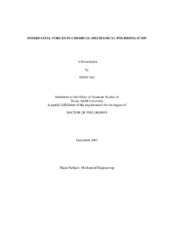| dc.description.abstract | The demand for microelectronic device miniaturization requires new concepts and technology improvement in the integrated circuits fabrication. In last two decades, Chemical-Mechanical Polishing (CMP) has emerged as the process of choice for planarization. The process takes place at the interface of a substrate, a polishing pad, and an abrasive containing slurry. This synergetic process involves several forces in multi-length scales and multi-mechanisms. This research contributes fundamental understanding of surface and interface sciences of microelectronic materials with three major objectives. In order to extend the industrial impact of this research, the chemical-mechanical polishing (CMP) is used as a model system for this study. The first objective of this research is to investigate the interfacial forces in the CMP system. For the first time, the interfacial forces are discussed systematically and comparatively so that key forces in CMP can be pinpointed. The second objective of this research is to understand the basic principles of lubrication, i.e., fluid drag force that can be used to monitor, evaluate, and optimize CMP processes. New parameters were introduced to include the change of material properties during CMP. Using the experimental results, a new equation was developed to understand the principle of lubrication behind the CMP. The third objective is to study the synergy of those interfacial forces with electrochemistry. The electro-chemical-mechanical polishing (ECMP) of copper was studied. Experiments were conducted on the tribometer in combination with a potentiostat. Friction coefficient was used to monitor the polishing process and correlated with the wear behavior of post-CMP samples. Surface characterization was performed using AFM, SEM, and XPS techniques. Results from experiments were used to generate a new wear model, which provided insight from CMP mechanisms. The ECMP is currently the newest technique used in the semiconductor industries. This research is expected to contribute to the CMP technology and improve its process performance. This dissertation consists of six chapters. The first chapter covers the introduction and background information of surface forces and CMP. The motivation and objectives are discussed in the second chapter. The three major objectives which include approaches and expected results are covered in the next three chapters. Finally chapter VI summarizes the major discovery in this research and provides some recommendations for future work. | en |


